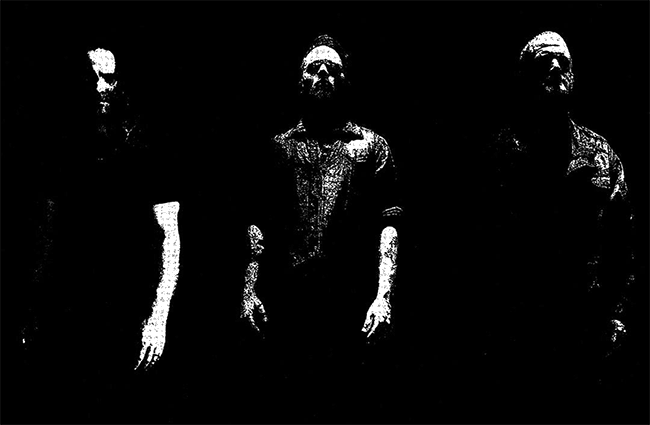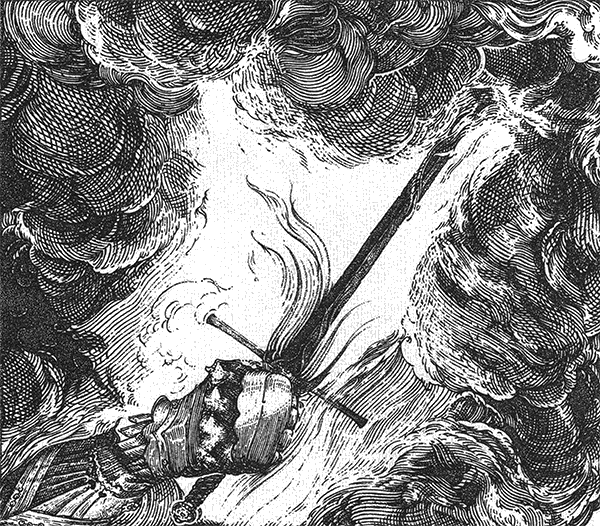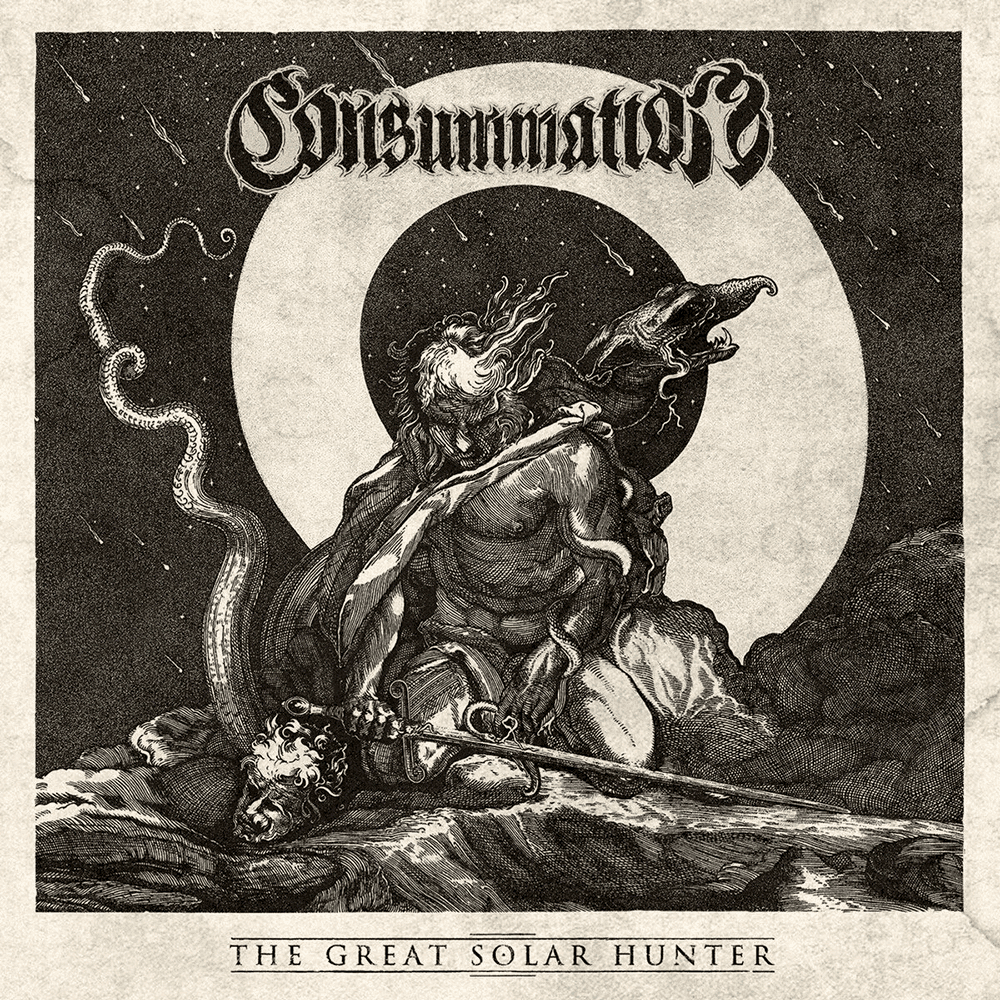Consummation
2019-08-07
by Niklas Göransson
A decade in the making, Australian death/black quartet Consummation has unleashed The Great Solar Hunter. Frontman Craig Young speaks of transcendence through violence, the discipline of suffering, and how the serpent brought the gift of sight.
– By definition, CONSUMMATION is a ritual of completion. It’s a vessel for me to explore my creative and philosophical impulses… or, more accurately, the philosophies of others which resonate the most with me. Aurally, it’s the ritual union of aphotic textures and epic, sombre passages with a draconian focus on riff-craft.
“The Great Solar Hunter”, was released by Profound Lore Records in June 2019. CONSUMMATION’s debut album comes two years after their “Ritual Severance” EP and seven years after the self-titled demo.
– CONSUMMATION has been a slow-moving machine thus far but, with the required effort, that will all change now that the album is done. I first started writing material back in 2009 but nothing really took shape until two years later. With the demo released I decided it would be a good time to form a live line-up, which presented an entirely new set of challenges. While its output is quite strong, the extreme metal scene in Brisbane is small with only a handful of people creating the majority of all noteworthy releases. Because of this, it’s very difficult to find musicians who aren’t already stretched over several projects, which was also true for me until a few years ago. We performed several shows at different times in various cities around Australia but, considering the logistical challenges involved, I decided it would be much better to strip everything back and focus solely on song-writing so we could record the album which had begun taking shape.
At this point, in 2016, CONSUMMATION consisted only of its two original members – Craig Young and Joel Rademaker – so it was time to find a new drummer.
– I’d met Dave Haley at shows a few times so I reached out and showed him what I’d been working on, following which he agreed to be a part of it. Soon after, we recorded “Ritual Severance” in what would later become the same process for “The Great Solar Hunter”. A bit of a logistical nightmare but, in the end, a useful learning experience. It’s worked thus far, and I believe it will continue to do so in the future.
As far as logistics go, John Gossard resides in the United States whereas Dave Haley is a fellow Australian but lives in Melbourne – two-hours by plane from Brisbane where Craig and Joel are based. Consequently, they never even had a full rehearsal with the recording line-up.
– Both Joel and Dave are immensely talented, so we have the freedom to approach the creative process a little differently than most. The song-writing stage is a fairly private affair for me, I like the immersion and solitude and have personally found that writing together with others can affect the cathartic nature of the creative process. So, I’ve always handled this on my own. Once the initial composing is completed, I hand everything over to Joel; he’s somewhat of a musical deviant who also prefers working on his own. He has a natural talent for finding space in the low end of music – the slough of despond, if you like – and implementing additional notes in a way that can make something sound even more unsettling. When all of this is complete, Joel and I go over the songs and decide on which areas need further enhancements; usually by adding melodies or orchestral passages. The material is then passed on to Dave who goes into the studio to lay down drums. Afterwards, we track all the guitars and vocals and then pass the result along to John for him to add some lead work. Seeing as how our approach to functioning as a band isn’t exactly traditional, “The Great Solar Hunter” was a huge learning curve for us but we made it work in the end.

“Ritual Severance” showed considerate musical evolution from the, in comparison, rather primitive demo – a custom they’ve certainly upheld with “The Great Solar Hunter”.
– Given the timeline of their creation, the progression was entirely natural. Despite having a relatively clear vision when I began writing what would ultimately become the demo, I was still fumbling in the dark a little. Over time, everything naturally grew more complex and nuanced as all aspects took shape in a more satisfying fashion. I’d say that “The Great Solar Hunter” is CONSUMMATION‘s first true representation whereas the “Ritual Severance” EP and the demo are documents of our journey to the present point. Overall, the album covers a lot of different ground and moves between dissonant chaos, more traditional black and death metal moments, and a bit more of the ‘epic’ sound that first emerged on “Ritual Severance”.
To assist in my research, Craig was kind enough to provide rather lengthy summaries of his lyrics. As it turns out, there’s quite a bit of effort and afterthought plied into them.
– “The Great Solar Hunter” is my own exploration – or even celebration – of the shadow of Man and its relationship to the constant struggle of ‘The Greater War’. Through mythological contexts and alchemical metaphor we explore the benefits of The Fall, the destructive yet cleansing nature of the Hero Archetype, as well as individuation through ‘shadow integration’ and embracing death. The concepts were a little more complicated than my ability to transcribe lyrics, but the essence is there and it’s my hope that listeners will read them and draw their own conclusions. Aurally, the album consists of five musical narratives making up the larger whole, each of which were then used as a vessel to explore the designated concept.
Craig’s explanation of “Blighted Ovum”, the second track of their 2017 EP, stated that it deals with ‘the idea that there is no divine reward for what we do on earth.’ That would imply that our deeds in life have no bearing over what happens when we die, a reasoning which sounds somewhat contradictory to several of their remaining concepts.
– When constructing a release, I like to ensure that everything has a relationship. Calling “Ritual Severance” a concept EP would be a bit strong but, thematically, “Blighted Ovum” follows on from where “The Weightless Grip of Fire” left off, which is the ritualistic approach to war and violence as a way to transcend mundane existence and, therefore, our own limitations. “Blighted Ovum” is essentially the return to pre-birth nothingness – ‘from whence it came’ – but the reality is that I, when putting together those lyrics, was really just momentarily indulging the more cynical parts of my own nature. Let’s call it a nihilistic fantasy to offset the grasp at glory of the first song.
Both the aforementioned “The Weightless Grip of Fire” and album song “The Eminent Fires of Sacrifice” deal with concepts pertaining to ascension through violence.
– The notion that the Kingdom of Heaven can be taken by storm is prevalent in a lot of ancient cultures throughout the world, including that of the greater Indo-European strata. Unlike the secular nature we’ve adopted for ourselves today, the ancient world was rife with religious attitude and a far more metaphysical approach to all things – including war. “The Weightless Grip of Fire” approaches the ritual nature of the much revered Úlfhédnar warriors mentioned within the setting of Ragnarök in the Völsunga saga. The idea of using ritual to elevate consciousness and initiate ‘possession’ before entering the unfathomably violent landscape of battle has always struck me as something that would not only be necessary but also imminently desirable if faced with the need to ‘step into the jaws of chaos’ in such a way. Creating a junction point between ‘invisible forces’ and the warriors themselves, for them to then perform on a higher plane in addition to the mundane.
Craig points out how, in many cultures, acts of violence perpetrated before death would appease the divine will of the gods and grant passage to the afterlife. One example from Norse mythology is the concept of the Valkyries who collect the souls of dead warriors to escort them to Valhalla – the proverbial Kingdom of Heaven.
– The same concept exists within other ancient cultures such as the Iranian-Persian tradition in which they’re known as Fravashi; also represented as ‘women of light’, they perform the same task as their Norse counterparts. Because of the cross-cultural nature of this idea, a more modern conceptualisation has come about where the Valkyrie, or Fravashi if you like, are actually the transcendental personification of aspects within the warriors themselves – supernatural forces by which their human natures can metamorphose and step beyond their normal limitations. “The Eminent Fires of Sacrifice” approaches a very similar theme and was inspired by sections within the Bhagavad Gita.
Craig refers to a passage from Knowledge of the Absolute, the seventh chapter of the Bhagavad Gita, which contains an extensive dialogue between the god Krishna and a warrior named Arjuna. Krishna is justifying an oncoming battle to Arjuna, who struggles with the more humanitarian elements of his nature. Excerpt:
I am the strength of the strong, devoid of passion and desire. I am the original fragrance of the earth and I am the heat in fire. I am the life of all that lives, and I am the penances of all ascetics. I am the original seed of all existence, the intelligence of the intelligent and the prowess of the powerful men.
– Viewing this exchange through a more metaphorical lens, it can be taken that both Arjuna and Krishna are different parts of the same whole – with Arjuna representing action within the physical plane whereas Krishna represents knowledge and the mystical. The idea taken is that the transcendental element of man is eternal, all-encompassing, and neutral about the individuals involved in the upcoming slaughter. Those who temporarily sacrifice their human nature to the eternal transcendence are then able to rise above the mundane, acting not as a person but instead an embodied representation of the numinous; embracing death, removing the limitations presented by our very humane lust for life.

“Ophidian Crown” takes both a cross-cultural and multidisciplinary approach to what in an Abrahamitic context is known as The Fall of Man, the serpent luring Adam and Eve to – against the express will of God – dine upon fruit from the Tree of the knowledge of good and evil, ultimately leading to their unceremonious eviction from the gardens of heavenly delight. CONSUMMATION debates whether this, in fact, wasn’t the greatest of all gifts and then links the notion to modern scientific research.
– The birth of consciousness is a common mythological motif throughout many religious traditions. The Buddha was also born into paradise and, until leaving his walled sanctum, remained unaware both of nature’s cruel indifference and his own capacity to suffer. There’s a notion that for human consciousness to properly function, it comes at the cost of limitation. Infinity is an intangible, abstract idea that’s impossible to properly comprehend; therefore, for the human mind to be able to operate inside a human anatomy in the material plane, we perceive the world around us through the boundaries our body places upon us – whether they be physical, emotional, etcetera. Consciousness cannot exist in our physical bodies without limitations and it’s precisely these limitations which cause the inevitable suffering of Being. In the Christian version of this story, Man is punished for his innate curiosity and cast out from paradise into the world where he’s condemned to suffer the limitations of flesh. The original notion here is that expulsion into the world was punishment for a sin; however, mankind is nothing without his suffering. The ability to endure hardship and overcome adversity is the bedrock of our greatest talents. Nietzsche spent a vast part of his life exploring this notion a lot deeper than most ever could.
Friedrich Nietzsche believed that the ‘discipline of suffering’ is what cultivates innovation and propels human excellence, a quality he regarded as noblest of all earthly traits. A woe-ridden soul is one which harnesses strength and willpower, and the greater the suffering – the more Man’s wanton desires are stripped down to his base survival instincts – the stronger the resilience it will foster in one’s character, assets applicable to both art creation and the advancement of science. Nietzsche argued that when the pursuit of happiness comes to dominate a culture, it will exert detrimental influences over its people. Individuals with innate capacities for greatness will be taught from an early age that suffering is a condition one must seek to alleviate. The craving for a problem-free existence robs them of their full potential; instead of creating through hardship they squander their energy, either by actively pursuing joy or wallowing in self-pity from the lack thereof. The German philosopher himself underwent his greatest period of productivity in conjunction with extreme and drawn-out physical torment, ‘uninterrupted three-day migraine, accompanied by laborious vomiting of phlegm’ being a typical spout of discomfort.
– The serpent in the Garden of Eden bestowed upon mankind the greatest gift we’ve ever received – human consciousness and willpower – the deadliest weapons in all of nature. This is why it’s stated within “Ophidian Crown” that ’scales grant vision’. As for the scientific links; there’s a recent notion known as Snake Detection Theory, first proposed by an anthropologist named Lynne Isbell, that human eyesight evolved to its high level as a way of detecting snake camouflage. Her belief is that early primates developed a keen eye for colour and dimension as a way of quickly detecting close-range threats. They’ve since furthered their research and shown how the human neuro-visual response to images of snakes is faster than that of any other animal tested in the study thus far. This is where the concept gets a little tricky and a lot more interesting. People already familiar with the work of Carl Jung will know about his theory of the collective unconscious.
Early 20th century Swiss psychologist Carl Gustav Jung, founder of analytical psychology, has been widely influential far outside his own academic discipline; fields such as philosophy, theology, archaeology, and anthropology have all benefited from his work. The collective unconscious, also known as the objective psyche, as a concept suggests that the deepest recesses of the unconscious mind has been moulded by one’s genetic ancestry rather than life experience. Jung believed that deeply rooted personal traits such as spiritual inclination, instincts, and human drives all stem from this murky reservoir of desires, emotions, thoughts, and memories. Inaccessible by our waking awareness, he described the collective unconscious as harbouring ‘mythological motifs or primordial images, for which reason the myths of all nations are its real exponents.’ As such, he proposed that the lore and legends of a culture mirror the objective psyche ingrained in its people.
– Jung believed myth and religious practice to have come first and understanding second; that the unconscious part of our psyche acts through us before the conscious part fully understands. If this is true, then the argument could be made that there’s a link between the mythological story of The Fall – the birth of human consciousness, or ‘sight’– and the Snake Detection Theory. Information from the evolution of our eyesight has left some deeply embedded residue within our unconscious. The devil is in the details…

The title track explores the monomyth concept – as brought to public attention by American Professor of Literature Joseph Campbell, a gentleman discussed extensively in the conversation with VANUM. In 1949 Campbell published his most influential book, The Hero with a Thousand Faces, through which he launched the theory of a cross-cultural heroic archetype, found throughout legends and religious traditions across the world. Having forged this conviction in younger years, it wasn’t until coming across the writings of the aforementioned Carl Jung he realised how to interpret myth metaphorically, as opposed to approaching them from a historical or factual perspective.
– With the repugnant surge of hollow superhero bullshit that our culture has seen over the past decade or so, it’s a little surprising that the name of Joseph Campbell doesn’t appear more often – especially considering the significance of the monomyth. The world has always been attracted to figures who go above and beyond what’s necessary for mere survival, often enshrining them with the title of Hero, and rightfully so. Entire cultures and civilisations have been carved around them; just look at the founding of Rome. Solar nature is a reference derived from the primitive forms of sun worship that later evolved into its personification in deities and then applied to the magnetism invoked by such individuals. These characters mesmerise people en masse, time and time again, to such an extent that they’re willingly led to their deaths carrying starry visions of a new world in their eyes.
You mentioned Alexander the Great as a real-life historical example, any others spring to mind?
– It only takes half a heartbeat to conjure up more names. Napoleon Bonaparte, Julius Caesar, Genghis Khan, Hannibal Barka, Attila the Hun and so on. The victors write history but the reality of people of such magnitude is always different; for something new to be created there will always be the inescapable destruction of what was there before it. This plays out in nature, over and over again, like a forest fire burning out the deadwood which will later be replaced by new undergrowth – mankind is no different. Death and rebirth, the triumphant cadence of Ouroborus.



